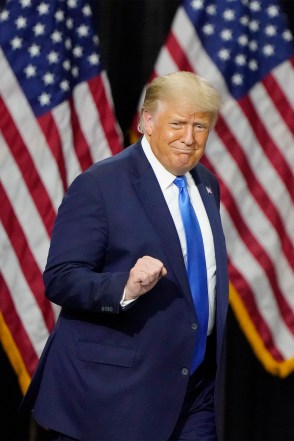Trump unveils health care plan, signs order protecting pre-existing conditions
President Trump outlined his long-awaited health care plan on Thursday, signing a series of executive orders he said are aimed at protecting Americans with pre-existing conditions, ending surprise billing and introducing more affordable public options.
The move comes as the Trump administration tries to overturn ObamaCare in the Supreme Court after getting rid of the key enforcement tool of the law, the individual mandate, when Congress eliminated the penalty for not having insurance.
Abolishing it could mean 20 million Americans lose their health insurance, though the case will not be heard until after the election.
“We’re delivering better care with more choice at a much lower cost and working to ensure Americans have access to the care they need,” Trump said of his “America First Health Care Plan” at an event in Charlotte, NC.
The first executive order requires that health insurance companies cover all pre-existing conditions for all customers, a move he floated in August.
President Barack Obama’s plan, formally known as the Affordable Care Act, already includes a provision that prevents insurers from discriminating against Americans with pre-existing medical conditions.
But railing against ObamaCare as a “terrible” plan that sent premiums soaring, Trump claimed the GOP was the new party of health care.


“The Democrats like to constantly talk about it, and yet pre-existing conditions are much safer with us than they are with them,” Trump said, slamming Joe Biden’s health care plan, which he said would result in “rationing care, denying choice, putting Americans on waitlists.”
“The historic action I’m taking today includes the first-ever executive order to affirm it is the official policy of the United States government to protect patients with pre-existing conditions, so we’re making that official,” he said.
The commander-in-chief described his plan as “three pillars,” the second offering more customizable plans, which he claimed would be 60 percent cheaper than his predecessor’s plan.
“When I took office, more than 50 percent of counties nationwide offered plans from only a single insurance company on the individual market,” Trump said.

“Starting next month, more than 90 percent of the counties will have multiple options to choose from, which is really some difference,” he went on, announcing small businesses would also be able to offer more affordable options to their employees.
“These are tremendous options that didn’t exist before we came into office, and through a massive expansion of health reimbursement arrangements, millions of Americans will be able to shop for a plan of their choice on the individual market.”
The second option will be legislation to end surprise billing and pushing for price transparency on hospital procedures.
“The days of ripping off American patients are over,” he vowed.
When asked if the administration had the legal authority to do this via executive order, Health and Human Services Secretary Alex Azar said, “We will work with Congress or otherwise to ensure that they’re protected.”
But Trump’s executive order does not carry the weight of an actual law if the Affordable Care Act is struck down by the Supreme Court.
Azar, meanwhile, charged that it was a “fallacy” that people with pre-existing conditions were protected by the ACA.
“If you’re a couple aged 65 living in Missouri making $70,000 a year, ObamaCare is going to cost you $30,000 in premiums and you have a $12,000 deductible. I’m sorry, that is not affordable coverage of your pre-existing condition,” Azar said.
“That is an insurance card that you can’t afford to actually use to take care of your pre-existing condition,” he went on.
Health care has emerged as a major issue in Trump’s first term, and in July he signed an executive order reducing the cost of prescription drugs.
On Thursday, he announced that his administration would also send cards loaded with $200 to more than 33 million Medicare recipients to help them pay for their prescription medicines.







